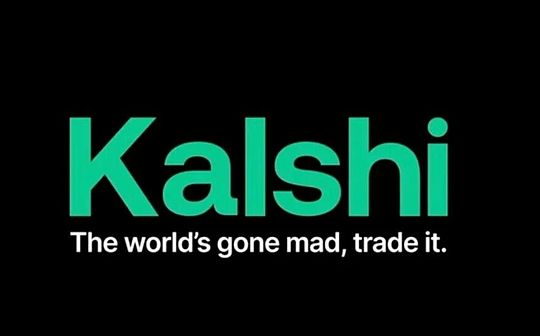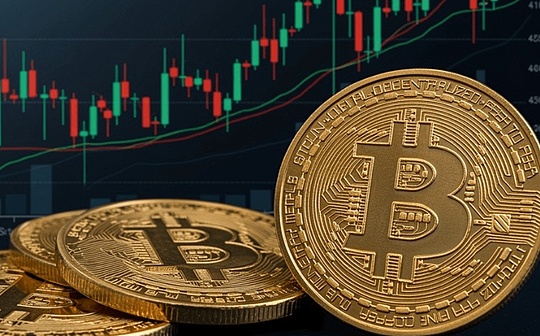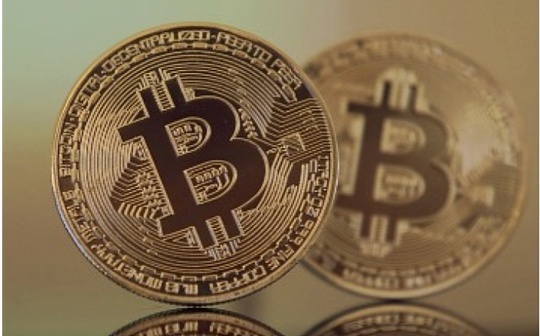
Author: Arthur Hayes, founder of BitMEX, Medium; compiled by: Deng Tong, Bitchain Vision
Ping, Ping, Ping, this is the sound of snowfall at night on various ski resorts in Hokkaido that my phone reminds me to monitor.While this sound brought me great joy in January and February, in March it only brought FOMO.
I set out from Hokkaido in early March and spent the past few ski seasons.My recent experience told me that Mother Nature started heating up the ski resort around March 1.I am a junior skier and I only like the driest and deepest ski resorts.However, this season, there have been huge changes.There is a cruel warm current in February that dispels the snow.The cold weather did not appear again until the end of the month.But the temperature in March is cold again, with 10 to 30 cm of fresh snow piled up every night.That’s why my phone keeps ringing.
Throughout March, I sat in various hot and humid countries in Southeast Asia, constantly silly checking the apps and ruining my decision to leave the ski resort.The gentle weather in April finally arrived and my FOMO ended with it.
As readers know, my skiing experience is a metaphor for my macro and cryptocurrency trading books.I have written before that the termination of Bank of America’s terminating financing program (BTFP) on March 12 will lead to a plunge in global markets.BTFP was cancelled and the vicious sell-off in the cryptocurrency sector did not occur.Bitcoin decisively broke through $70,000, reaching a maximum of around $74,000.Solana continues to rise with various puppies and kittens Memecoin.My timing is wrong, but like the ski season, unexpected favorable conditions in March won’t repeat in April.
Although I like winter, summer also brings joy.The arrival of summer in the Northern Hemisphere has brought me the fun of sports, and I rescheduled my time to play tennis, surfing and kiteboards.Thanks to the policies of the Federal Reserve and the Treasury Department, a new round of influx of fiat currency liquidity will be ushered in in the summer.
I will briefly outline my mind map to see how and why the risk asset market will experience extreme weakness in April.For those who bravely short cryptocurrencies, the macro setting is favorable.Although I won’t be completely shorting the market, I’ve closed a few shit coins and Meme coins trading positions and made a profit.From now until May 1, I will be in the non-trading zone.I hope to come back in May with dry gunpowder, prepare for the real start of the bull market.
fraud
Bank term financing plans (BTFP) ended a few weeks ago, but U.S. non-Too-Big-to-Fail (TBTF) banks did not face any real pressure afterwards.This is because the high priests of fraudulent finance have a series of tricks, and they will use secret printing of money to save the financial system.I will peek behind the scenes and explain how they can expand the US dollar fiat supply, which will support the general rise in cryptocurrencies – until the end of the year.Although the final result is always printing money, this process is not without a period of slowing liquidity growth, which provides a negative catalyst for the risk market.By carefully studying this series of techniques and estimating when a rabbit will be pulled out of the hat, we can estimate when a period when a free market is allowed to operate.
Discount window
The Fed and most other central banks operate a tool called a discount window.Banks and other covered financial institutions that require funds can pledge eligible securities to the Fed in exchange for cash.Overall, the Discount Window currently accepts only U.S. Treasury (UST) and Mortgage-Backed Securities (MBS).
Suppose a bank is screwed up because of a bunch of Pierce and Pierce baby boomers puppets running it.The bank held UST worth $100 when it was purchased, but is currently worth $80.Banks need cash to meet deposit outflows.Insolvent shit banks can take advantage of the discount window instead of declaring bankruptcy.Banks convert US$80 in USD to USD notes because the market value of the pledged securities is received by the current rules.
To abolish BTFP and eliminate related negative stigma without increasing the risk of bank failure, the Federal Reserve and the U.S. Treasury Department are now encouraging troubled banks to use the discount window.However, under current collateral terms, the discount window is not as attractive as the recently expired BTFP.Let’s go back to the example above to understand why.
Remember that the value of UST fell from $100 to $80, which means the bank has an unrealized loss of $20.Initially, the $100 UST was provided by a $100 deposit.But now the UST is worth $80; therefore, if all depositors escape, the bank will have a shortage of $20.Under BTFP rules, the bank receives face amounts of underwater UST.This means that US$80 worth of UST will be exchanged for $100 in cash when delivered to the Fed.This restores the bank’s solvency.But the discount window only offers $80 for US$80 worth of US$80.The $20 loss remains, and the bank remains insolvent.
Given that the Fed can unilaterally change collateral rules to balance the treatment of assets by BTFP and discount windows, the Fed continues to carry out invisible banking bailouts by giving the green light to the insolvent banking system.So the Fed essentially solves the BTFP problem; the entire UST and MBS balance sheets of the insolvent U.S. banking system (I estimate $4 trillion) will support the loans when needed through funds printed on the discount window.That’s why I don’t think the market has forced any non-TBTF banks to go bankrupt after the BTFP ended on March 12.
Bank capital requirements
Banks are often asked to fund governments that issue bonds at yields below nominal GDP.But why do private for-profit entities buy something with negative real yields?They do this because banking regulators allow banks to buy government bonds with little or no down payment.When banks that have under-capital buffers on government bond portfolios inevitably collapse due to inflation and the falling bond prices as yields rise, the Fed allows them to use the discount window in the above manner.Therefore, banks would rather buy and hold government bonds than provide loans to businesses and individuals who need funds.
When you or I buy anything with borrowed money, we have to mortgage collateral or equity to deal with potential losses.This is prudent risk management.But if you are a vampire squid zombie bank, the rules are different.After the 2008 Global Financial Crisis (GFC), World Bank regulators tried to force global banks to hold more capital, thus creating a more robust and resilient global banking system.The system of rules that incorporate these changes into the code is called Basel III.
The problem with Basel III is that government bonds are not considered risk-free.Banks must invest a small amount of capital into their vast sovereign bond portfolio.These capital requirements have proven to be problematic during times of stress.During the March 2020 market crash, the Federal Reserve issued a decree that banks could hold UST without collateral support.This allows banks to step in and store trillions of dollars worth of UST in a risk-free way…at least in terms of accounting.
When the crisis eases, UST’s Supplementary Leverage (SLR) exemption is restored.It is predictable that banks went bankrupt due to insufficient capital buffering as UST prices fell due to inflation.The Fed is taking the rescue through BTFP and now discount windows, but that can only make up for the losses caused by the last crisis.At the current unattractive high prices, how can banks increase their efforts and absorb more bonds?
The U.S. banking system claimed in November 2023 that Bad Goul Yellen could not stuff more bonds into them as Basel III forced them to hold more capital in their government bond portfolios.Therefore, some concessions must be made because there are no other natural buyers in the U.S. government to buy their debts when the real rate of return is negative.Here are the ways banks politely express their unstable situation.
Demand for U.S. Treasury bonds by some traditional buyers may have been weak.Bank securities portfolio assets have been declining since last year, with banks holding $154 billion less Treasury bonds than a year ago.
Powell-led Fed once again saved the situation.At a recent U.S. Senate banking hearing, Powell suddenly announced that banks would not be subject to higher capital requirements.Remember, many politicians are calling on banks to hold more capital to prevent the 2023 regional banking crisis from happening again.Apparently, banks are struggling to lobby to eliminate these higher capital requirements.They have a good argument – if you, Bad Gurl Yellen, want us to buy shit government bonds, then we can only make a profit with unlimited leverage.Banks around the world manage various types of governments; the United States is no exception.
The icing on the cake is a recent letter from the International Swap Dealers Association (ISDA) proposing to exempt UST from the SLR I talked about earlier.Essentially, if banks are not required to pay any down payment, they can only hold trillions of dollars in UST to finance the U.S. government deficit on a future basis.I expect the ISDA proposal to be accepted as the U.S. Treasury Department increases its debt issuance efforts.
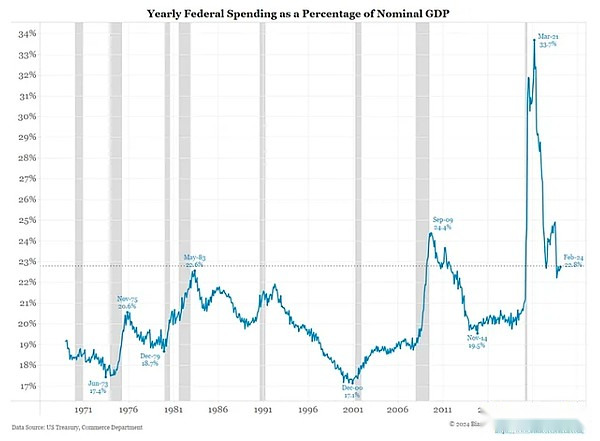
This excellent chart from Bianco Research clearly shows how wasteful the U.S. government is evidenced by the record high deficit.The high deficit spending in the last two periods is the 2008 global financial crisis and the baby boomer-led lockdown.The U.S. economy is growing, but the government is spending money like an economic depression.
All in all, relaxing capital requirements and possibly eliminating UST from SLR in the future is a concealed way to print money.Instead of printing money, the Fed creates credit currency out of thin air and buys bonds, which then appears on its balance sheet.As always, our goal is to ensure that government bond yields do not rise above nominal GDP growth rates.As long as the real interest rate remains negative, the prices of stocks, cryptocurrencies, gold, etc. that will be calculated in fiat currencies will continue to rise.
Bad Gurl Yellen
My article “Bad Gurl” delves into how the U.S. Treasury, led by Bad Gurl Yellen, can increase the issuance of short-term T-bills to exhaust the trillions of dollars locked in the Fed’s reverse buyback (Recommended)retail price).As expected, the decline in MSRP occurred concurrently with rising stocks, bonds and cryptocurrencies.But now that the MSRP has dropped to $400 billion, the market wants to know what the next source of legal liquidity will boost asset prices.Don’t worry, Yellen wasn’t finished speaking yet, shouting “It’s almost time to drop the spoil.”
RRP Balance (White) and Bitcoin (Yellow)
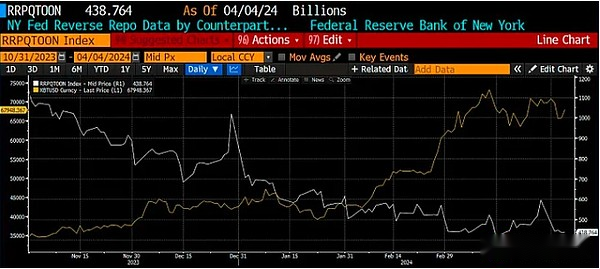
The statutory funds flows I will discuss focus on U.S. tax payments, the Federal Reserve’s quantitative austerity (QT) program, and the Treasury Department’s General Account (TGA).The timeline discussed is from April 15 (the tax due date for the 2023 tax year) to May 1.
Let me provide a quick guide on their positive or negative effects on liquidity to help you understand what these three things mean.
Taxation eliminates liquidity in the system.This is because taxpayers must withdraw cash from the financial system by selling securities, etc. before they can pay taxes.Analysts expect tax payments in the 2023 tax year will be high due to large amounts of interest income received and solid stock market performance.
QT eliminates liquidity in the system.As of March 2022, the Fed allowed UST and MBS worth approximately $95 billion to mature without reinvesting the proceeds.This has led to a decline in the Fed’s balance sheet, which is known to reduce the liquidity of the dollar.However, what we care about is not the absolute level of the Fed’s balance sheet, but the speed of its decline.Analysts such as Joe Kalish of Ned Davis Research expect the Fed to reduce QT by $30 billion per month at its May 1 meeting.As the Fed’s balance sheet decline slows, the slowdown in QT pace is good for US dollar liquidity.
When the TGA balance rises, it eliminates liquidity from the system, but when the TGA balance falls, it increases liquidity into the system.When the Treasury receives taxes, the TGA balance increases.I expect the TGA balance will be well above the current level of about $750 billion with tax processing on April 15.This is the liquidity of the US dollar is negative.Don’t forget that this is election year.Yellen’s job is to re-election her boss, US President Joe Biden.This means she must do everything she can to stimulate the stock market and make voters feel rich, and attribute this great achievement to Biden’s slow “genius” in economics.When the RRP balance eventually drops to zero, Yellen will spend TGA, likely to release an additional $1 trillion in liquidity into the system, which will boost the market.
The unstable period for risky assets is from April 15 to May 1.At this point, taxation eliminates liquidity in the system, QT will continue to operate at the current higher rate, and Yellen has not started to reduce TGA.After May 1, the pace of QT slowed down and Yellen was busy cashing checks to raise asset prices.If you are a trader looking for the right time to build a cheeky short position, April is the perfect time.After May 1, it’s back to the regular plan…asset inflation initiated by the financial mischief of the Federal Reserve and the U.S. Treasury Department.
Bitcoin halving
Bitcoin block rewards are expected to be cut in half on April 20.This is seen as a bullish catalyst for the cryptocurrency market.I agree that it will push up prices in the medium term; however, the previous and subsequent price movements can be negative.The claim that halving is good for cryptocurrency prices is already ingrained.The opposite usually happens when most market participants agree on a certain outcome.that’s whyI believe that Bitcoin and cryptocurrency prices will generally plummet before and after halving.
Given that the halving occurs when the dollar liquidity is more tense than usual, it will add momentum to the crazy sell-off of crypto assets.The timing of halving further increased my decision to give up the deal by May.
So far, I have made full profits on positions like MEW, SOL and NMT.The proceeds are deposited into USDe of Ethena and pledged to earn huge gains.Before Ethena, I held USDT or USDC and got nothing, while Tether and Circle received full Treasury yields.
Can the market overcome my bearish tendency and continue to move higher?Yes.I’ve always been passionate about cryptocurrencies, so I welcome mistakes.
When I was taking a two-step walk on Token2049 Dubai, do I really want to see my most speculative junk coin position?It must not work.
Therefore, I fell in love.
There is no need to be sad.
If the dollar liquidity scenario I discussed above becomes a reality, I will be more confident to imitate all kinds of shit.If I missed a few percentage points of gain but definitely avoided the loss of my portfolio and lifestyle, that was an acceptable result.That’s it, I’ll say goodbye to you.Remember to put on your dance shoes and we will meet you in Dubai to celebrate the cryptocurrency bull market.



